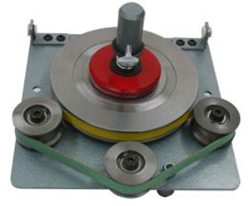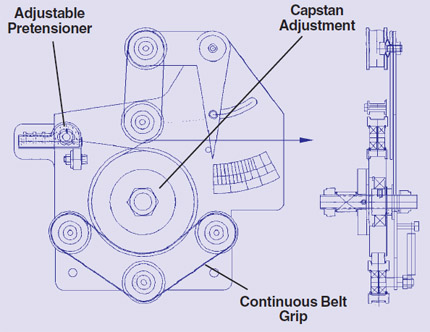Model PDCBU-1
Capstan Belt Tension Units
Whenever constant payoff tension is required, in either high or low speed situations, capstan belt tension units should be used. They neutralize speed variances and provide constant tension from start-up to shut down.
 Typical applications include:
Typical applications include:
- Extruding
- Bunching
- Stranding
- Rewinding
- Braider bobbin winding
- Strand annealing
Production processes require sufficient, constant payoff pressure to:
- Provide a consistent, repeatable process.
- Maintain payoff material properties.
- Keep the product straight for outer coating applications.
- Prevent payoff material movement.
- Stretch or keep payoff material taut during applications.
Standard CBU-3 Unit
| RANGE: | Bare Copper: | 0.5 to 3.0 mm |
| Bare Steel: | 0.1 to 2.0 mm | |
| Insulated Wire: | 0.52 to 6.02 mm | |
| Mad-made Fibers: | 0.1 to 6.0 mm | |
| OPTIONS: | CBUI-5: Unit with indicator arm for readings against a scale for quick, easy adjustment (see drawing). | |
| CTUE-D: Unit with electrical digital readout for recordable, repeatable tension settings. | ||

Operation
The material being paid off is threaded through the entry eyelet. It is then wrapped around the outer capstan wheel's profile and passes between the spring-loaded, continuous flat belt and the capstan's outer profile to keep the material from slipping. The wire’s path may vary according to the capstan unit used. The payoff material exits the capstan through the exit eyelet. Tension can be adjusted to suit the production process while the material is being paid off.
Using a capstan tension belt unit with a tension arm indicator or digital controller allows a visual setting of the correct tension without guess work. This unit can also be set up for remote tension adjustment or connected to a computer link.
Specify the size and type of material being run, the running speed and required tension. We’ll recommend the capstan unit you need.
Description
A capstan belt tension unit is comprised of a steel back plate on which a capstan wheel is mounted. This wheel has an adjustable brake which acts against the wheel’s rotation and a continuous flat belt guided by flat pulleys. A spring action against the outer profile of the capstan ensures that the material passing the flat belt and the capstan wheel’s outer profile cannot slip. In some instances, a pretension unit is mounted at the entry position (prior to the capstan) to maintain constant capstan input tension. Guides and/or pulleys are positioned to keep the material in the correct path.
Tension variances occur in almost any payoff situation. For example:
If a reel or bobbin is rotated to unwind material for production, two tension controls are required:
- Starting and stopping tensions: In a rolloff payoff situation, the starting tension is the maximum tension that will be induced during this procedure, typically 4 times the running tension. It is very important to control this tension to eliminate the initial “stick/stickslip” phenomena and accelerate the mass of the bobbin. Constant tension during stopping eliminates slackness and the production of bad material.
- Running tension: This is the tension needed to keep the mass running at a constant velocity or throughput speed; it is typically 1% of the bobbin weight. Particularly in flyer payoff situations, the running tension will vary significantly as the reel changes from full to empty, reducing mass and causing a change in the fleeting angle.
If a reel or bobbin is stationary when material is unwound for production, it is generally paid out over the reel's end, and only one tension control is required:
- Material tension: This is the tension induced in the material to rotate the unwinding device, which is usually a rotatable cap (spinner disc unit) or a flyer arm. This tension will increase as the winding diameter decreases as the material is paid off. A typical ratio is 2:1 (flange to barrel), but other flange-to-barrel ratios exist, particularly for smaller diameter wires.
A capstan belt tension unit after payoff neutralizes variance and provides smooth, constant tension for production processes. It can be easily adjusted and set with confidence.
Optional Equipment
When tension control is critical, use a capstan belt tension unit with an optional tension arm indicator or digital controller to allow accurate visual settings. This will help to:
- Eliminate "guestimates".
- Log settings used for future reference or modifications.
- Adjust settings remotely or through a computer link.